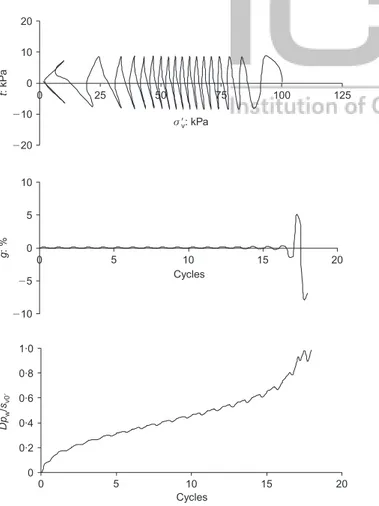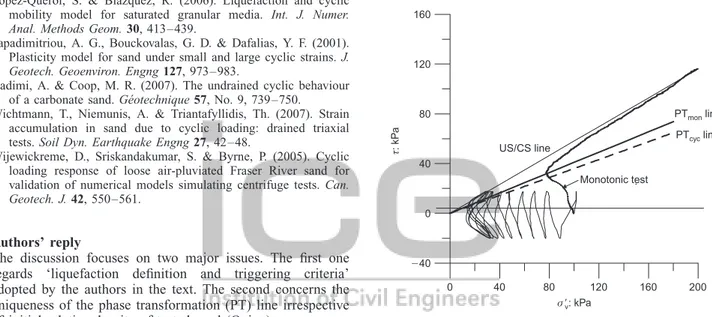Delivered by ICEVirtualLibrary.com to: IP: 192.167.50.117
Thu, 04 Mar 2010 10:26:28
Porcino, D. et al. (2010). Ge´otechnique 60, No. 4, 303–305 [doi: 10.1680/geot.8.D.021]
303 DISCUSSION
Undrained monotonic and cyclic simple shear behaviour of
carbonate sand
D. P O R C I N O, G . C A R I D I a n d V. N. G H I O N NA ( 2 0 0 8 ) . G e´ o t e c h n i q u e 5 8 , N o . 8 , 6 3 5 – 6 4 4
S. Lo´pez-Querol, Universidad de Castilla La Mancha The authors establish a final strain of 3.75% as the final criterion of failure. According to the extensive research available in the literature (i.e. Arulmoli et al., 1992; Wijewickreme et al., 2005), this value is rather insufficient for assessing if the sand fails or not, or even the type of failure, especially for dense samples. In Fig. 18, an example of what in the discusser’s opinion a liquefaction failure is, is presented on Fraser River sand (loose sample), in terms of stress path, shear strain against number of cycles and development of excess pore water pressure. Conversely, Fig. 19 represents a result for the same sand, under dense initial conditions. This last result shows a clear cyclic mobility type of failure, the shear strains at the end of the test reaching values close to 10%. The main difference between these failures is not particularly given by the shear strain, but mainly by the excess pore water pressure evolution. For liquefaction, at the end of the test, this curve displays a sudden change of slope, while for cyclic mobility this does
not happen. In the authors’ opinion, Fig. 4 represents a liquefaction type of failure, while, in the discusser’s opinion, it might more likely be of cyclic mobility type, as, although the amplitude of the shear strains increases with the number of cycles, at the end of the test it still remains a small value. A higher number of cycles, and a higher strain level, would be necessary for determining what actually happens. In Fig. 5, the authors show a case of what they call cyclic mobility, which is not really this kind of failure: when in these tests a static shear stress is applied, there is no symmetry in the loading conditions, and consequently the shear strain does not oscillate around a zero value but around an accumulated strain as the cycles go on. This fact is because the shear strength in loading, dependent on the current shear stress (Papadimitriou et al. 2001), is rather different from unload-ing situations, and this leads to the accumulation of shear strain in the loading direction (Wichtmann et al. 2007). If test C13-L (Fig. 5) would have lasted longer, probably liquefaction failure would have happened (Qadimi & Coop, 2007). ⫺20 ⫺10 0 10 20 0 σ⬘v: kPa 125 100 75 50 25 ⫺10 ⫺5 0 5 10 0 Cycles 20 15 10 5 : kP a t g : % 0 0·2 0·4 0·6 0·8 1·0 0 Cycles 20 15 10 5 Dp s wv 0 / ⬘
Fig. 18. Example of liquefaction failure on Fraser River sand
under CSS test: initial relative density: 0.40; ó9v0 100 kPa;
CSR 0.08 (after Wijewickreme et al., 2005, test CSS100-0.08)
⫺60 ⫺40 ⫺20 0 20 40 60 0 σ⬘v: kPa : kP a t ⫺10 ⫺5 0 5 10 0 Cycles g: % 0 0·2 0·4 0·6 0·8 1·0 0 Cycles 225 200 175 150 125 100 75 50 25 35 30 25 20 15 10 5 35 30 25 20 15 10 5 Dp s wv 0 / ⬘
Fig. 19. Example of cyclic mobility failure on Fraser River sand
under CSS test: initial relative density: 0.81; ó9v0 200 kPa;
Delivered by ICEVirtualLibrary.com to: IP: 192.167.50.117
Thu, 04 Mar 2010 10:26:28 According to the authors, the strong dependence of the
phase transformation line slope on the initial relative density of the sand, demonstrated by means of extensive experimen-tal research, is denied for the particular case of Quiou sand (carbonate material), and well justified through cyclic simple shear test results. Therefore, the dilative behaviour of this sand is independent of its initial density, which is a rather particular behaviour, even for carbonate sand. The cyclic liquefaction or cyclic mobility failure type usually depends on the phase transformation line location in the ó9–ô plane, for cyclic simple shear tests results: the smaller the slope, the denser the sand, and the more dilative behaviour would be expected, closer to cyclic mobility failure type (Lo´pez-Querol & Bla´zquez, 2006).
REFERENCES
Arulmoli, K., Muraleetharan, K. K., Hossain, M. M. & Fruth, L. S. (1992). VELACS Laboratory Testing Program, Soil Data Report, Report to the National Science Foundation, Washington D.C. Irvine, California: The Earth Technology Corporation.
Lo´pez-Querol, S. & Bla´zquez, R. (2006). Liquefaction and cyclic mobility model for saturated granular media. Int. J. Numer. Anal. Methods Geom. 30, 413–439.
Papadimitriou, A. G., Bouckovalas, G. D. & Dafalias, Y. F. (2001). Plasticity model for sand under small and large cyclic strains. J. Geotech. Geoenviron. Engng 127, 973–983.
Qadimi, A. & Coop, M. R. (2007). The undrained cyclic behaviour of a carbonate sand. Ge´otechnique 57, No. 9, 739–750. Wichtmann, T., Niemunis, A. & Triantafyllidis, Th. (2007). Strain
accumulation in sand due to cyclic loading: drained triaxial tests. Soil Dyn. Earthquake Engng 27, 42–48.
Wijewickreme, D., Sriskandakumar, S. & Byrne, P. (2005). Cyclic loading response of loose air-pluviated Fraser River sand for validation of numerical models simulating centrifuge tests. Can. Geotech. J. 42, 550–561.
Authors’ reply
The discussion focuses on two major issues. The first one regards ‘liquefaction definition and triggering criteria’ adopted by the authors in the text. The second concerns the uniqueness of the phase transformation (PT) line irrespective of initial relative density of tested sand (Quiou).
With regard to the first issue, the authors refer to the specific terminology recommended by the National Centre for Earthquake Engineering Research (NCEER) (1997) Workshop to describe ‘cyclic softening’ phenomena. The authors have already mentioned in the paper that the criter-ion adopted to define undrained cyclic strength at the occurrence of a 3.75% maximum (total) shear strain (within a cycle) was mainly due to the need for a better control of undrained/constant volume test conditions in the adopted NGI type SS apparatus. However, it is worth noting that a similar criterion has been adopted by several researchers, such as Ishihara (1993) and Seed et al. (2003).
From a general standpoint the authors agree with the discussers that it would have been more appropriate to terminate tests at higher shear strain levels in order to better recognise the pattern of behaviour exhibited by the sample for a higher number of cycles. This can be particularly relevant for specific problems, such as the response of offshore structures subjected to repeated loading under a large number of cycles, or for problems involving sloping ground conditions (Wu et al. 2004).
The second aspect raised by the discussers concerns the uniqueness of the PT line, irrespective of the initial relative density of tested sand (Quiou). First, the authors want to stress that for the tested sand, the monotonic phase transfor-mation (PTmon) line and cyclic phase transformation (PTcyc) line are significantly different, which seems to be a general
behaviour pattern of calcareous soils, as exhaustively pointed out by Mao & Fahey ( 2003). This feature should be consid-ered as a peculiar characteristic of calcareous soils, as it is not observed in silica sands.
As an example, Fig. 20 shows the correspondence be-tween undrained monotonic and cyclic PT lines gathered by the authors in companion simple shear (SS) tests carried out on a well-documented Italian silica sand, namely Ticino sand (TS), with similar grain size distribution to Quiou sand (QS).
The results gathered by the authors in the tests described in the paper indicate that the cyclic PT line of QS is poorly dependent on initial void ratio. These findings are supported by similar conclusions drawn by Mao & Fahey (2003) from undrained cyclic simple shear tests carried out on three calcareous soils. It is important to remember that the PTmon line represents a key element in determining the observed undrained cyclic response of carbonate soils under both simple shear and triaxial conditions (Hyodo et al., 1998). The results reported in the authors’ paper show that, for
0 σ⬘v: kPa ⫺40 0 40 80 120 160 τ: kP a PTmonline US/CS line PTcycline Monotonic test. 200 160 120 80 40
Fig. 20. Correspondence between undrained monotonic and
cyclic response of Ticino silica sand (dense specimens) from SS tests σ⬘3 0 0 40 80 120 160 200 LD - CI HD - CI LD - CK0 HD - CK0 PT linemon(φ⬘ ⫽PT 36·5°) q : kP a ⫽⫺ σσ13 120 80 40 p⬘ ⫽ ⬘ ⫹(σ1 2 )/3: kPa
Fig. 21. Phase transformation line gathered from undrained monotonic triaxial compression tests carried out on Quiou sand at different initial void ratios (loose and dense) and
consolida-tion stress states (isotropic and K0)
Delivered by ICEVirtualLibrary.com to: IP: 192.167.50.117
Thu, 04 Mar 2010 10:26:28 Quiou sand, the PTmon line is relatively unaffected by initial
density state. This feature is confirmed by recent results gathered by the authors from undrained monotonic triaxial compression tests carried out on specimens of Quiou sand (loose¼ LD and dense ¼ HD), prepared by the same recon-stitution method (water sedimentation) adopted in SS tests. Triaxial tests were conducted under both isotropic and K0 consolidation stress state. Fig. 21 clearly reveals that the PTmon envelope is not influenced by relative density nor by consolidation stress state.
In any case, the authors believe that further research and efforts are required to have a better insight into the different behaviours observed in undrained monotonic and cyclic tests carried out on carbonate and silica soils.
REFERENCES
Hyodo, M., Hyde, A. F. L. & Aramaki, N. (1998). Liquefaction of crushable soils. Ge´otechnique 48, No. 4, 527–543.
Ishihara, K. (1993). Liquefaction and flow failure during earth-quakes. Ge´otechnique 43, No. 3, 351–415.
Mao, X. & Fahey, M. (2003). Behaviour of calcareous soils in undrained cyclic simple shear. Gee´otechnique 2003, 53, No. 8, 715–727.
National Center for Earthquake Engineering Research (1997). Pro-ceedings of the NCEER workshop on evaluation of liquefaction resistance of soils (eds T. L. Youd and I. M. Idriss), Technical Report No. NCEER-97-0022, 31 December 1997. Buffalo: NCEER.
Seed, R. B., Cetin, K. O., Moss, R. E. S., Kammerer, A. M., Wu, J., Pestana, J. M., Riemer, M. F., Sancio, R. B., Bray, R. E., Kayen, R. E. & Faris, A. (2003). Recent advances in soil liquefaction engineering: a unified and consistent framework. 26th Annual ASCE Los Angeles Geotechnical Spring Seminar, Keynote presentation, H.M.S. Queen Mary, Long Beach, Cali-fornia, 2003, 1–71.
Wu, J., Kammerer, A. M., Riemer, M. F., Seed, R. B. & Pestana, J. M. (2004). Laboratory study of liquefaction triggering criteria. Proc. 13th World Conf. Earthquake Engng, Vancouver, Paper No. 2580.

